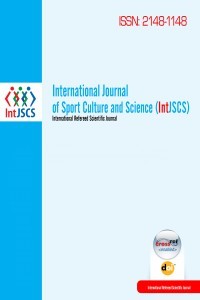Determination of Optimal Readiness to Specialized Loadings of Qualified Boxers and Fencers on the Basis of the Integral Indicator of Coordination Abilities
Accuracy, Ball Throwing, Coordination Abilities, Training Session, Workability,
___
- Kiselev VA (2006). Sovershenstvovaniye sportivnoy podgotovki vysokokvalifitsirovannykh bokserov: uchebnoye posobiye. Fizicheskaya kul'tura: 127.
- Ozolin NG (2004). Nastol'naya kniga trenera: Nauka pobezhdat'. Moskva. Izdatel'stvo «Astrel'»: 863. Platonov VN (2015). Sistema podgotovki sportsmenov v olimpiyskom sporte. Obshchaya teoriya i yeyo prakticheskiye prilozheniya: uchebnik dlya trenerov. v 2 kn. Kiyev. Olímpíys'ka líteratura. Kn. 1: 680.
- Romanenko VA (2005). Diagnostika dvigatel'nykh sposobnostey. Donetsk. Don NU: 290.
- Shinkaruk O, Ulan A (2016). porti niy íd ír í orí ntatsíya píd oto ki sportsmení urak u annyam unktsíonal'noí asimetríí: teoretic ní peredumo i. Teoríya í metodika fízichnogo vikhovannya í sportu, 1: 15-18.
- Shiryayev AG (2002). Boks uchitelyu i ucheniku. Izdaniye 2-ye, pererabotannoye i dopolnennoye. Sankt-Peterburg. « aton»: 190.
- Sharipov AF, Malkov OB (2007). Taktiko-tekhnicheskiye kharakteristiki poyedinka v sportivnykh yedinoborstvakh. Moskva. Fizkul'tura i Sport: 224.
- Tyshler DA, Movshovich AD (2007). Dvigatel'naya podgotovka fekhtoval'shchikov. Akademicheskiy proyekt: 153.
- ISSN: 2148-1148
- Başlangıç: 2013
- Yayıncı: Uluslararası Bilim Kültür ve Spor Derneği (UBİKS)
Saeed SAHEB BAYATI, Gholamreza KHAKSARY, Majid SOLEYMAN
A. Gökçe GAYRETLİ, H. Mehmet TUNÇKOL
Shahla NAGHIBI, Mina HAKAKZADEH, Mohammad Ebrahim RAZAGHI
İzzet KIRKAYA, Deniz ŞİMŞEK, Günay YILDIZER, Elvin Onarıcı GÜNGÖR
İpang SETIAWAN, Dhimas Bagus DHARMAWAN, Endro Puji PURWONO, Cahyo YUWONO
